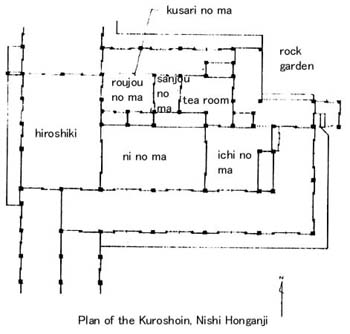|
||
 |
||

(C)2001 Japanese Architecture and Art Net Users System. No reproduction or republication without written permission.
掲載のテキスト・写真・イラストなど、全てのコンテンツの無断複製・転載を禁じます。
|
||||||
| kusari-no-ma 鎖の間 | ||||||
| KEY WORD : architecture / tea houses | ||||||
| Lit. chain room. The origin of the term is unclear. According to the FUHAKU HIKKI 不白筆記 (notes written by Kawakami Fuhaku 川上不白 ;1716-1807), the kusari-no-ma was either a place where food was cooked for guests or where the guests ate after the tea ceremony was performed. Adjacent to the tea ceremony room *chashitsu 茶室 or *sukiya 数寄屋, was a place for storing and washing utensils *mizuya 水屋, which was sext to the kusari-no-ma, which was believed to have been about four mats, yojou 四畳 or to six mats, rokujou 六畳 in size. The FUHAKU HIKKI also states that the room contained a long firebox *dairo 大炉. As recorded in the YOUSHUUFUSHI 擁州府志 (1684), according to Sen Rikyuu 千利休 (1522-91), a kusari-no-ma was a room where cooking was done and trays of food were prepared for the guests. The YOUSHUUFUSHI states that a kettle, suspended by an iron chain, was hung over the firebox. The formal drawing room *shoin 書院, has a chain with a hook at the the end on which to hang a kettle over the sunken hearth *ro 炉. Examples: 1 The kusari-no-ma (also called rokujou-no-ma 六畳間) at Nishihonganji Kuroshoin 西本願寺黒書院 in Kyoto, is a six mat room with a shelved cabinet, the top of which has doors, and below, closets. This room is separated from the tea ceremony room by a three-mat room. 2 Ekansansou Chaya 恵観山荘茶屋 at Joumyouji 浄明寺 in Kanagawa prefecture. Built in 1652, it was moved from Kyoto to the premises of Yamada Soui 山田宗囲 (1908- ) at Joumyouji and used for the Souhen school of tea, Souhenryuu 宗偏流, founded by Yamada Souhen 山田宗偏 (1627-1708). | ||||||
 |
||||||
| REFERENCES: | ||||||
| *saya-no-ma 鞘の間 | ||||||
| EXTERNAL LINKS: | ||||||
| NOTES: | ||||||
(C)2001 Japanese Architecture and Art Net Users System. No reproduction or republication without written permission. 掲載のテキスト・写真・イラストなど、全てのコンテンツの無断複製・転載を禁じます。 |
||||||